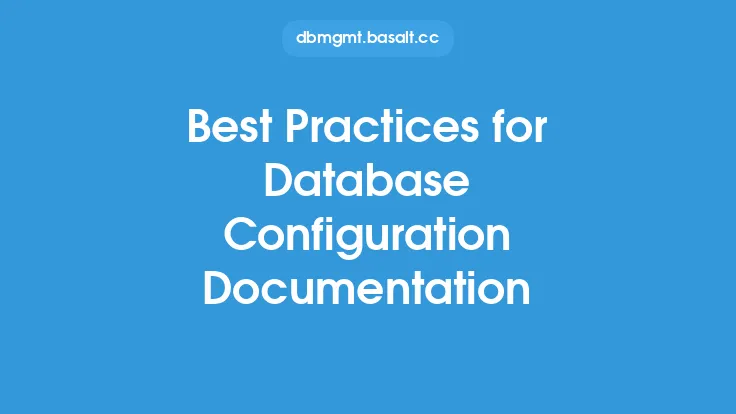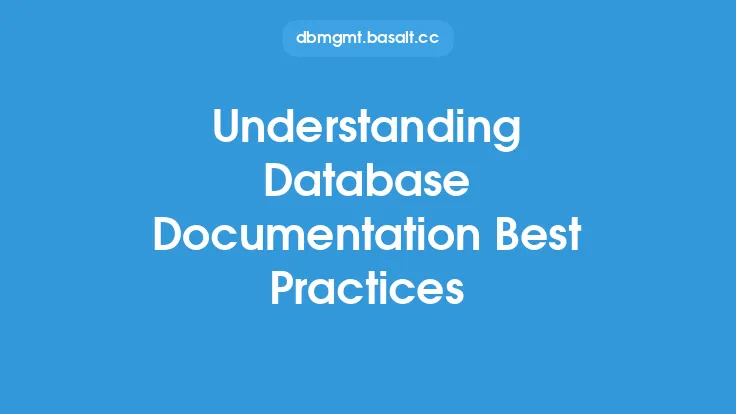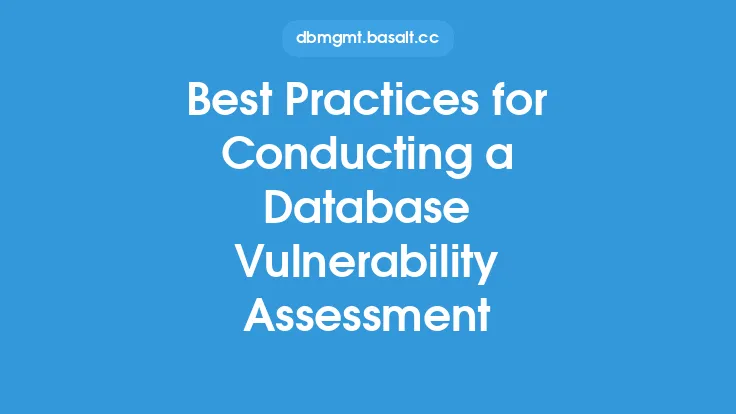When it comes to database configuration, there are several best practices that can help ensure the optimal performance, reliability, and security of a database. A well-configured database is essential for any organization that relies on data to operate, as it can help prevent data loss, improve query performance, and reduce the risk of security breaches. In this article, we will explore the key aspects of database configuration and provide guidance on how to configure a database for optimal results.
Introduction to Database Configuration
Database configuration refers to the process of setting up and optimizing a database management system (DBMS) to meet the specific needs of an organization. This includes configuring database parameters, setting up storage and networking, and implementing security measures. A good database configuration can help improve the performance and reliability of a database, while a poor configuration can lead to issues such as slow query performance, data loss, and security vulnerabilities.
Database Configuration Parameters
Database configuration parameters are settings that control the behavior of a DBMS. These parameters can be used to optimize performance, improve security, and configure storage and networking. Some common database configuration parameters include:
- Buffer cache size: This parameter controls the amount of memory allocated to the buffer cache, which is used to store frequently accessed data.
- Sort area size: This parameter controls the amount of memory allocated to the sort area, which is used to sort data during query execution.
- Log file size: This parameter controls the size of the log files, which are used to store database transactions.
- Connection timeout: This parameter controls the amount of time a connection can remain idle before it is terminated.
Database Storage Configuration
Database storage configuration refers to the process of setting up and optimizing storage for a database. This includes configuring disk storage, setting up storage area networks (SANs), and implementing storage virtualization. A good storage configuration can help improve the performance and reliability of a database, while a poor configuration can lead to issues such as slow query performance and data loss. Some best practices for database storage configuration include:
- Using redundant storage to protect against data loss
- Configuring storage to optimize I/O performance
- Implementing storage virtualization to improve flexibility and scalability
Database Networking Configuration
Database networking configuration refers to the process of setting up and optimizing networking for a database. This includes configuring network protocols, setting up firewalls, and implementing encryption. A good networking configuration can help improve the security and performance of a database, while a poor configuration can lead to issues such as security vulnerabilities and slow query performance. Some best practices for database networking configuration include:
- Using secure network protocols such as SSL/TLS
- Configuring firewalls to restrict access to the database
- Implementing encryption to protect data in transit
Database Security Configuration
Database security configuration refers to the process of setting up and optimizing security for a database. This includes configuring authentication and authorization, setting up access controls, and implementing encryption. A good security configuration can help protect a database against security threats, while a poor configuration can lead to issues such as data breaches and unauthorized access. Some best practices for database security configuration include:
- Using strong authentication and authorization mechanisms
- Configuring access controls to restrict access to sensitive data
- Implementing encryption to protect data at rest and in transit
Database Configuration Tools and Techniques
There are several tools and techniques that can be used to configure and optimize a database. These include:
- Database configuration scripts: These are scripts that can be used to automate the configuration process.
- Database tuning tools: These are tools that can be used to optimize database performance.
- Database monitoring tools: These are tools that can be used to monitor database performance and identify issues.
- Database configuration templates: These are templates that can be used to configure a database for a specific use case.
Best Practices for Database Configuration
There are several best practices that can be followed to ensure a database is properly configured. These include:
- Following a structured configuration process
- Testing and validating configuration changes
- Documenting configuration changes
- Implementing change management processes
- Continuously monitoring and optimizing database performance
Conclusion
In conclusion, database configuration is a critical aspect of database implementation that requires careful planning and attention to detail. By following best practices and using the right tools and techniques, organizations can ensure their databases are properly configured to meet their specific needs. This can help improve the performance, reliability, and security of a database, while also reducing the risk of issues such as data loss and security breaches. Whether you are configuring a database for a small application or a large enterprise, following the guidelines outlined in this article can help ensure your database is properly configured for optimal results.





